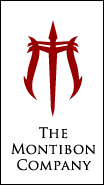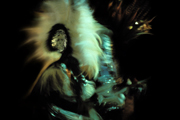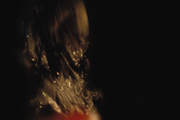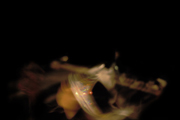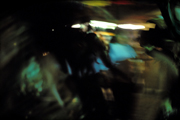MINISTRY OF STRATEGIC ARTISTIC IMPROVISATION
Adventures in Art, Photography, Design & Technology™
PHOTO | GRAPHIC | IMAGE | ARTS
Five unstructured and unrepentant ruminations on art, vision, signs, symbols, graphic depiction and photographic imagery.
Introduction:
Both the foundational and advanced education of artists, designers and
photographers are flawed. Oriented toward either technical training or critical theory, conventional
arts education leaves many arts professionals unclear on the middle ground—the core issues their
professions are based upon. From the nature of perception; to communication as mind-to-mind sharing
based on a set of ever-changing agreements and contexts; from the projection of meaning by the
recipient; to the relevance lifespan of a work in the real world—these writings examine these issues.
Roy Montibon :: Artist | Strategist | Creative Director | Designer | Educator
Founder + Creative Director, The Montibon Company, LLC and
Sanctuary Studios
Julie Tumblety :: Artist | Photographer | Art Director | Educator
Founder + Art Director, The Montibon Company, LLC and
Sanctuary Studios
.....................
BEGINNING at the BEGINNING:
LEARNING and UNLEARNING
For any artist, learning is important, but unlearning what one has learned in the past is just as important. Much of what we learn in art and design classes is presented out of context, or in a context that is misleading. Some of what is taught is just plain wrong. Worse, with arts programs having been decimated in U.S. public schools over the past four decades, for a student to be exposed to any arts-related instruction (much less, integrated, quality arts programs) prior to college is rare.
When I refer to learning I am referring to a wholly separate activity than what passes for education, particularly here in the United States. Education is to learning as morality is to values. Education and morality are externally imposed structures. Learning and values are internal. One's core values and how one learns are expressions of one's inner life, independent of institutionally, politically or socially imposed imperatives.
This does not mean that morals (and by extension, laws), or education are not necessary in our imperfect human societies, it merely means that artists must approach their growth not through the passive acceptance of "received knowledge", but through self-guided exploration, direct experience and focused internal development. Becoming an artist is not an academic pursuit, nor it is just about the practical acquision of knowledege and skill. More than anything, it is about critical thinking and attaining coherence (but not necessarily consistency) in one's work. It is also about being effective, but not necessarily efficient.
An artist does not allow external forces to form or control his or her inner life. An artist creates his or herself, thoughtfully and deliberately, within themselves, with or without the help of mentors. It is important for artists to examine the cultural and social expectations that they were born into, and the elements of cultures and micro-cultures they adopt—in relationship to other cultures, and micro-cultures.
In order to do this properly, the artist must set aside things that they have been taught that will impede their internal artistic development. This process of self-construction and de-construction, of nurturing and pruning, making and remaking, is continuous throughout an artist's life. An artist must develop a capacity for patience and tenacity, and not give into the conforming, soul-crushing forces that surround them.
During the course of my teaching experience, I have taught university students and working professionals working in every form and in every medium: musicians, filmmakers, writers, graphic designers, interface designers, and so on. But for the purposes of PHOTO | GRAPHIC | IMAGE | ARTS, when I use the word "artist" or "artists" I am specifically referring to visual artists focused on originating the new, whether it be in the realm of painting, sculpture, photography, or the varieties of design, including architecture and interior design, fashion, furniture, product and graphic design.
(Creating the new, by the way, may encompass everything from the concept of originality, to the variety of approaches incorporating some form appropriation, from papier colle to remixes, mashups and readymades.)
On the other hand, I am not referring to craftspeople or to traditional artists, who are working within a defined set of criteria, processes and/or expectations. Traditional art, folk art and craftwork itself is an entire universe unto itself, worthy of deep discussion—in another thought piece.
In the context of this set of essays, "artists" refers to visual culture creators.
To be an artist requires critical thinking as a way of life. It involves directly experiencing life, seeing acutely and feeling deeply—not just note taking in the lecture hall and looking at other people's work. It involves constant questioning, not just of authority, but of everything, particularly those things that are commonly accepted as "givens"—common notions about meaning, perception and the nature of reality. Since language, image and symbology are the primary tools for propagating the norms of the prevailing society, attention to the subtleties of language, image and symbology are crucial to the artist.
In addition to assuring that one is not blindly accepting the preconceptions of others, the development of an artist involves the willful destruction of one's own preconceptions—among the most difficult things to do. The earlier that one starts down this path the easier it is. Becoming an artist is not something one accomplishes—it is a painstaking, yet exhilirating, lifelong process. One cannot simply print up a business card with the title "Artist" or "Designer", on it and consider the job done. One has to become an artist, again, every morning when one rises.
Becoming an artist again each day requires continuous challenging of oneself. Habit and laziness are poison to the artist. It is important for the artist to do something extremely difficult, every day. The challenge does not need to be artistic in nature, but it should be a real challenge.
What is a real challenge? A real challenge may be reconciling with a difficult parent or sibling, or tackling one's fears head-on, (such as fears of heights or of public speaking); or doing something that requires extreme attention and skill, such as learning to ice climb or ride a motorcycle. It is important that the outcome of the challenge rest entirely in your own hands. If your heart isn't pounding, if the hair is not standing up on the back of your neck, if you are not weak in the knees, or feeling slightly ill... it's not a true challenge. Life is not a theme park or a game, and more than anything, an artist must truly live life in order to produce work of substance.
Out of this approach to becoming an artist, these five short ruminations cover a range of issues that I have found in my years of teaching to be sources of confusion among both students of the arts and creative professionals.
Some of the thoughts we will cover include: the notions, preconceptions, misconceptions and downright delusional thinking surrounding art, photography, graphics, images and art derived from photographic images: the formation of imagery by complex neural and nervous system actions and interactions; memories of images; binocular vision, evil twins, mirror images, reflections and self-reflection; and the relationship of imagery to vision.
The images that accompany these writings are not illustrations of any specific subjects being discussed, but are examples of work done with the above thoughts in mind.
May some of these ramblings challenge some of your preconceptions, and by doing so, bring you some enjoyment, if not actual enlightenment.
- Roy Montibon
A graduate of Art Center College of Design, Roy Montibon has taught and mentored over 6,000 artists, designers and media professionals—undergraduates, graduate students and working professionals—for more than 24 years. The author addresses areas of significant confusion in these five short essays. These essays are excerpted direcly from from Roy's lectures and course notes Powerful Design, Fundamentals of Design and The Creative Process, delivered from 1987 through 2010 in the UCLA Extension Visual Arts and Design-Communication Arts programs; from lectures on new media delivered at a variety of universities and conferences in California; and from innumerable conversations and mentoring sessions with students and young professionals. These thoughts and links have been updated for PHOTO | GRAPHIC | IMAGE | ARTS.
Julie Tumblety used her organizational and management skills to develop and oversee a program at UCLA Extension offering approximately 160 courses per year for over 14 years. The courses she developed included 3D modeling, 3D animation, game design, art, graphic design, photography, interactive media design, interface design. She also developed training courses and workshops for above- and below-the-line film industry professional for the International Alliance of Theatrical Stage Employees, (IATSE), helping to form an entire generation of Hollywood film and television professionals in Los Angeles, home to the global film and television industry. Tumblety's understanding of the needs of the marketplace and her contacts with creative and technical professionals allowed her to develop curriculum, track developments in creative and technology industries, identify top talent and place industry professionals as instructors to lead courses designed for undergraduates, graduate students and design/media arts professionals.
Roy and Julie are the founders of the Ministry of Strategic Creative Improvisation, (mSCI). are writing a book (Design Career | Creative Path) and produce professional development seminars (Adventures in Art, Design, Technology & Culture) that cover creative process issues including: Vision, Mission, Strategy, Experience Design, Unconventional Thinking and Counterintuitive Planning, Coherent Decision Making, Improvisational Methodologies, Mental Landscaping, and Random Distruptions and Intentional Spontaneity.
For more information:
The Montibon Company, LLC
TMC on LinkedIn
Sanctuary Studios
